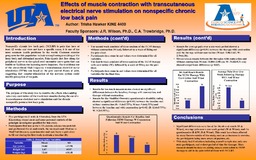
ATTENTION: The works hosted here are being migrated to a new repository that will consolidate resources, improve discoverability, and better show UTA's research impact on the global community. We will update authors as the migration progresses. Please see MavMatrix for more information.
Show simple item record
| dc.contributor.author | Hawker, Trisha | |
| dc.date.accessioned | 2017-04-25T19:56:16Z | |
| dc.date.available | 2017-04-25T19:56:16Z | |
| dc.date.issued | 2015 | |
| dc.identifier.uri | http://hdl.handle.net/10106/26625 | |
| dc.description | KINE 4400 | en_us |
| dc.description.abstract | Non specific chronic low back pain (NCLBP)is pain that lasts at least 12 weeks and does not have a specific cause, it is one of the most common health problems in the world. Common exercise programs for this population include strengthening/stretching of the large back and abdominal muscles. Pain signals that flow along the peripheral nerves to the spinal cord encounter nerve gates that can inhibit or facilitate the incoming nerve impulses. The traditional use of the conventional high-frequency transcutaneous electrical nerve stimulation (TENS)was based on the gate control theory of pain, suggesting that counter-stimulation of the nervous system could modify perception of the pain. | en_US |
| dc.description.sponsorship | Faculty Sponsor, J.R. Wilson | en_US |
| dc.description.sponsorship | Faculty Sponsor, C.A. Trowbridge | en_us |
| dc.language.iso | en_US | en_US |
| dc.title | Effects of muscle contraction with transcutaneous electrical nerve stimulation on nonspecific chronic low back pain | en_US |
| dc.type | Presentation | en_US |
| dc.publisher.department | Department of Kinesiology, The University of Texas at Arlington | en_us |
| dc.publisher.department | Exercise Science Research Laboratories, The University of Texas at Arlington | en_us |
Files in this item
- Name:
- Hawker T.pdf
- Size:
- 499.4Kb
- Format:
- PDF
- Description:
- PDF
This item appears in the following Collection(s)
Show simple item record


